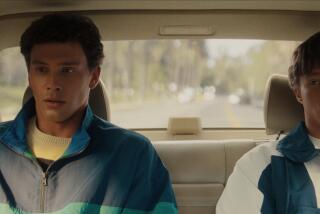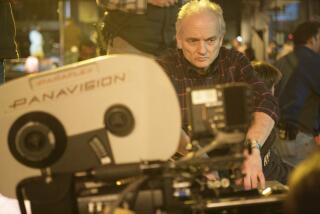MOVIE REVIEW : ‘GoodFellas’: Meaner Streets
To see an artist working at the peak of his power, everything extraneous stripped away, every element there for a purpose, is an extraordinary exhilaration.
Martin Scorsese gave us that pure, hot, unquestioned power last in “Raging Bull” and, in virtuosity alone, “GoodFellas” is “Raging Bull” squared. (It opens Friday at selected theaters.)
Scorsese has hardly been marking time in the 10 years between the two; “After Hours” and his “Life Lessons” segment of “New York Stories” showed just how much he has matured, grown more intelligently ironic and is even more astonishingly in command of his craft. “GoodFellas,” which somehow mixes its horrors with a deep vein of mordant humor, flows with the exuberance of a filmmaker who has every detail nailed and a few new lovely moves he wants to show us.
His characters--a savage quartet that includes Robert DeNiro, a truly chilling Joe Pesci, Paul Sorvino and Ray Liotta--are the same ones he has been considering since “Mean Streets”: the wise guys of his neighborhood, different from us in that pity seems to have been left out of their DNA and an off-handed brutality slipped into its place.
Obviously, this is Coppola’s and Puzo’s turf, too, but Coppola’s grandiose characters, rubbing shoulders with senators and popes, are like figures from grand opera. Scorsese’s gangsters, his wise guys, are pure street level, they’re the stuff of popular song that Scorsese threads through his picture--Tony Bennett, Bobby Vinton, the Crystals.
“GoodFellas’ ” no-nonsense street tone comes straight from journalist Nicholas Pileggi’s book “Wise Guy,” a shrewd distillation of 30 years in the Mafia through the eyes of one of its sidewalk mechanics. Half-Sicilian, half-Irish Henry Hill (Liotta) began by running nimbly for the wise guys at the corner cabstand when he was 12; 30 years later, when it became clear that it was either them or him, he turned on them with exactly the same agility.
Pileggi’s book provided Scorsese with a great, dense, sociological canvas, and the men’s close collaboration on the screenplay has given the dialogue a rolling repetitive poetry, streetwise, cheerfully obscene, the real article. Scorsese seems to have absorbed all the book’s details and made them visual. When Pileggi describes the cabstand’s gangsters, “so large that when they hauled themselves out of their cars, the vehicles rose by inches,” we see the car wheeze and rise as 280 pounds of camel’s-hair coat steps out onto a Brownsville curb. When new wise guy wife Karen Hill is introduced to her Mafia sisters at a “hostess party” it’s with a funny-awful collage of teased hair, facial masks, racial slurs and motherly tips about keeping the kids in line with belts and broomsticks.
There is a rise and fall to the action, but it’s subtle, not ‘30s gangster-style. When young Henry (Christopher Serrone) gets hooked on his heroes, it’s the early ‘60s, just on the crest of the golden age of the wise guys. Then, before Puzo’s “Godfather” and Sen. McClennan’s subcommittee on investigations, it was still possible for a naive and “attracted” Karen Freid (Lorraine Bracco, more than holding her own in this company) from a Long Island Jewish family, not to realize exactly what her worldly young boyfriend Henry really did for a living.
Back then the guys killed, “whacked” whoever got in their way. They chiseled and hijacked as a matter of course. But drugs--Hill’s downfall--weren’t as much of the everyday scene that they would become 15 years later. And greed and suspicion hadn’t yet infected DeNiro’s genially murderous Jimmy Conway, sending him on a lethal spiral which signaled to Henry that now was the time to get out--or join the ranks of the missing.
Those ranks, Freddy No Nose, Johnny Roastbeef, Jimmy Two Times and the fatally nudgy toupee king Morrie Kessler (Chuck Low) are part of the creepy fun of the movie. Scorsese lets us smile at their preening excesses, their kidding-on-the-square--the half-laughing threat to Henry by Joe Pesci’s Tommy DeVito that freezes all laughter at the wise guy’s table. Then in a moment that confirms our darkest fears about DeVito, he abruptly shuts down the laughs forever. Only the tension is left and this flawless cast plays that perfectly. No horror film carries the fright of Jimmy Conway’s friendly invitation to Karen that she pick out a dress for herself . . . down the street a little, at that darkened doorway.
In the same way that his narrator changes from Henry to Karen and back again, Scorsese’s camera moves and changes with his character’s rhythms. The director and his great cinematographer Michael Ballhaus have a rapturous time with Henry’s bid to impress Karen. The scene begins outside the Copa. As Henry forces $20 bills on unprotesting headwaiters, the camera dives with them down its side entrance, into its industrial entrails, its kitchen, up to its bar and onto its nightclub stage, where a busboy triumphantly sets down a white-covered table for two just as Henny Youngman begins his routine--all in one sinuous shot.
Showing off? Not Scorsese. The cocky Henry is showing off for Karen; the camera’s fluid, bravura movements simply match the kid and his mood. In the same way, in an hilarious sequence late in the film, as a pink-eyed and paranoid Henry bolts through a drug-drenched Sunday, trailed at one point by a hovering helicopter, the camera’s moves become as speedy and whacko as he is. (The perfect editing hand of Thelma Schoonmaker is, as usual, Scorsese’s conscience and guiding force.)
“GoodFellas,” which begins in literal blackness and ends in sunshine and the blackness of Henry Hill’s soul, is like a guided tour through a particular hell, with Scorsese as our faintly smiling guide standing a little aloof from the goings-on. He doesn’t need to moralize, he’d rather let a close-up look at the life do it for him.
‘GOODFELLAS’
A Warner Bros. release of an Irwin Winkler production. Producer Winkler. Executive producer Barbara De Fina. Director Martin Scorsese. Screenplay Nicholas Pileggi, Scorsese based on Pileggi’s book “Wiseguy.” Camera Michael Ballhaus. Editor Thelma Schoonmaker. Production design Kristi Zea. Art direction Maher Ahmad, set decoration Les Bloom. Costumes Richard Bruno. Sound James Sabat, Tom Fleischman. With Robert DeNiro, Ray Liotta, Joe Pesci, Lorraine Bracco, Paul Sorvino, Chuck Low, Frank Sivero, Tony Darrow, Mike Starr, Christopher Serrone.
Running time: 2 hours, 26 minutes.
MPAA-rated: R (extreme violence and language)
More to Read
Only good movies
Get the Indie Focus newsletter, Mark Olsen's weekly guide to the world of cinema.
You may occasionally receive promotional content from the Los Angeles Times.










